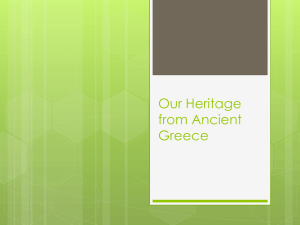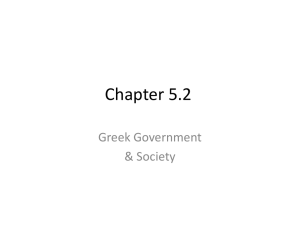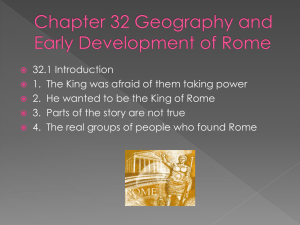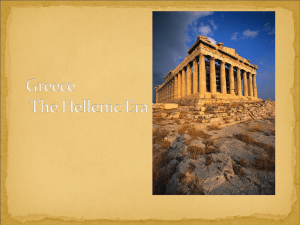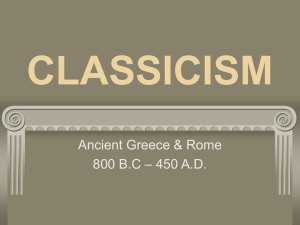PHILANTHROPY IN THE GREEK WORLD by the Rev
advertisement
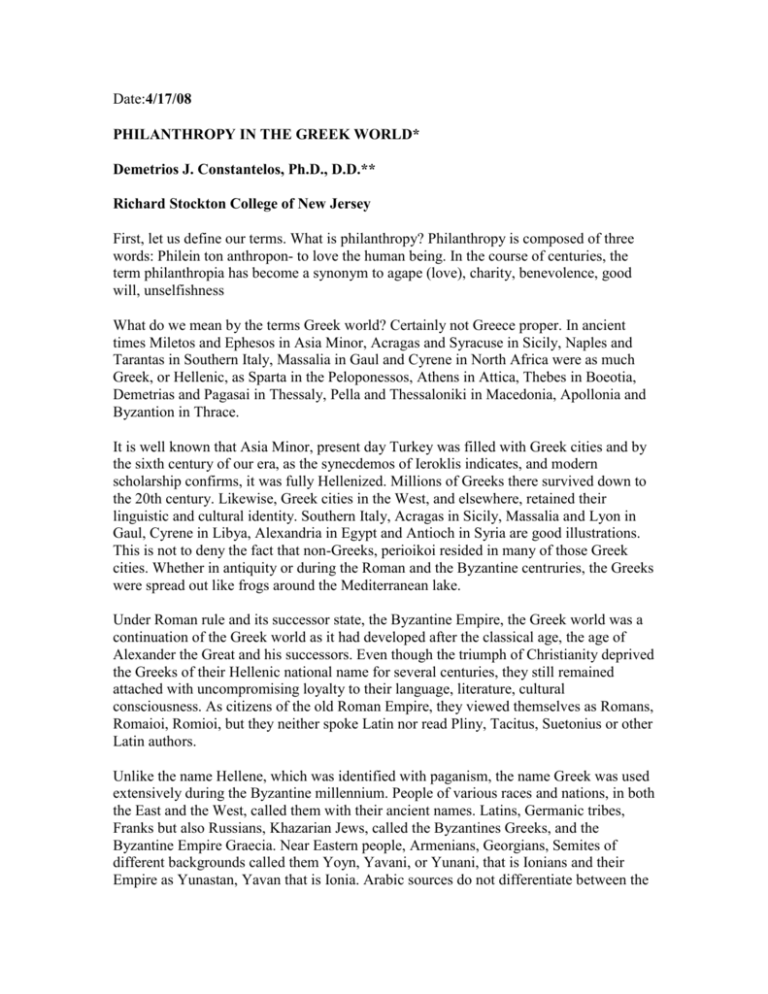
Date:4/17/08 PHILANTHROPY IN THE GREEK WORLD* Demetrios J. Constantelos, Ph.D., D.D.** Richard Stockton College of New Jersey First, let us define our terms. What is philanthropy? Philanthropy is composed of three words: Philein ton anthropon- to love the human being. In the course of centuries, the term philanthropia has become a synonym to agape (love), charity, benevolence, good will, unselfishness What do we mean by the terms Greek world? Certainly not Greece proper. In ancient times Miletos and Ephesos in Asia Minor, Acragas and Syracuse in Sicily, Naples and Tarantas in Southern Italy, Massalia in Gaul and Cyrene in North Africa were as much Greek, or Hellenic, as Sparta in the Peloponessos, Athens in Attica, Thebes in Boeotia, Demetrias and Pagasai in Thessaly, Pella and Thessaloniki in Macedonia, Apollonia and Byzantion in Thrace. It is well known that Asia Minor, present day Turkey was filled with Greek cities and by the sixth century of our era, as the synecdemos of Ieroklis indicates, and modern scholarship confirms, it was fully Hellenized. Millions of Greeks there survived down to the 20th century. Likewise, Greek cities in the West, and elsewhere, retained their linguistic and cultural identity. Southern Italy, Acragas in Sicily, Massalia and Lyon in Gaul, Cyrene in Libya, Alexandria in Egypt and Antioch in Syria are good illustrations. This is not to deny the fact that non-Greeks, perioikoi resided in many of those Greek cities. Whether in antiquity or during the Roman and the Byzantine centruries, the Greeks were spread out like frogs around the Mediterranean lake. Under Roman rule and its successor state, the Byzantine Empire, the Greek world was a continuation of the Greek world as it had developed after the classical age, the age of Alexander the Great and his successors. Even though the triumph of Christianity deprived the Greeks of their Hellenic national name for several centuries, they still remained attached with uncompromising loyalty to their language, literature, cultural consciousness. As citizens of the old Roman Empire, they viewed themselves as Romans, Romaioi, Romioi, but they neither spoke Latin nor read Pliny, Tacitus, Suetonius or other Latin authors. Unlike the name Hellene, which was identified with paganism, the name Greek was used extensively during the Byzantine millennium. People of various races and nations, in both the East and the West, called them with their ancient names. Latins, Germanic tribes, Franks but also Russians, Khazarian Jews, called the Byzantines Greeks, and the Byzantine Empire Graecia. Near Eastern people, Armenians, Georgians, Semites of different backgrounds called them Yoyn, Yavani, or Yunani, that is Ionians and their Empire as Yunastan, Yavan that is Ionia. Arabic sources do not differentiate between the ancient and Byzantine Greeks. They emphasized the unity and the continuity of the Greek, or Hellenic, world. For practical purposes I prefer to speak, of non-Christian, and Christian Hellenism. Unity in diversity was a major characteristic of the ancient Greeks – a unity through language, religious beliefs, ethnic consciousness and cultural traditions. Modern anthropologists concerned with physical life, remind us that the growth, development, and continuity of a culture does not necessarily change with the adoption of a new religion. A new religion may be the product of its founder but its propagation can not be understood outside of its milieu. Its ultimate growth depends on the thought world on which it is drafted. Old beliefs and moral principles reappear transformed, nevertheless essentially the same. Concepts such as philanthropia, philoxenia, dikaiosyne, isonomia that we find in ancient Greek theory and practice contributed to the formation of the ethos of Hellenism of the Christian era and beyond. In the last seventy five years, if not earlier, we have gone far beyond the disputes, when Christian theologians claimed that the ancient world did not know any love, and classical scholars who maintained that Christianity was the cause for the decline of the classical world. Today we know that many of the leading ideas of Christianity were not alien and totally unfamiliar to later Hellenism. We now know that the cleavage between Hellenism and Christianity was not as great and disruptive between the two. We know what Hellenism received from Christianity and how much Christianity owes to Hellenism. Even after the condemnation of Athens and what it represented by some early Christian theologians, such as Tertullian and Tatian, who sought to replace Athens with Jerusalem, Athens continued to influence the descendents of Jerusalem, both Jews and Christians. “The damned pagans,” Socrates and Plato, Aristotle and Zeno were perceived as instruments for God’s purposes. Faith and reason were not antithetical. Furthermore we know that there are several other indications, literary and cultural, that confirm this continuity of Hellenism, including their understanding and practice of the communion of the human with the Divine. From as early as the Homeric times, sacramental communion is perceived as communion of the worshipper with the Divinity. The blood sacrifice evolved into ta apyra iera, sacred sacrifices offered with no fire used such as cereals and fruits, bread and wine, used by Clement of Alexandria to describe the sacrifice of Christ. The partaking of the blessed bread and the cup of wine used in Greek antiquity has entered into the Christian mystical and liturgical lexicon. Whether the theanthropic and anemaktos thysia that we find in ancient Greek religious practices, or the Eucharistic communion of Christian practice, both emphasize its necessity for the Communion of the believer with the Divinity. But this is a different topic, not for discussion here. My purpose is to explain, how the idea and practice of Hellenic philanthropia, drafted into Christian agape, constitutes an indication of the continuity in the Hellenic heritage. A For the concept of philanthropy we have to go back to the classical age of ancient Hellenism. The Greek tragedian Aeschylus reminds us that Prometheus, the demigod, decided to bring to earth fire and empower humans with knowledge and skills because of his great philantrhopia for the future of humankind. He was bound to a crag and had his liver eaten daily, an image often identified with crucifixion, because of his love for humans. Centuries later, Paul of Tarsus wrote that the philanthropia of God for the salvation of humankind became manifest through the incarnation of God’s Logos (Titus 3:4). The practical application of philanthropy is related by Luke in the Book of Acts with reference to the attitude of the natives of Malta toward Paul and other prisoners on their way to Rome (Acts 27-28.11). In both cases, the torment of Prometheus and the crucifixion of Jesus the Christ were attributed to their philanthropia for humanity. The Divinity’s love for humankind is expressed through other terms: agapao, agape, agapetos, and phileo, philios, philotes, from which we have the term philanthropia— philein ton anthropon, to love the human being. While agapao and agape are rarely used in the Homeric epics and the later Greek literature, phileo, philios, philotes appear four times as often as agapao, agape. It is in the post classical literature of both Greeks and Greek-speaking Jews—the Suptuagint, New Testament, papyri, Plutarch, and others— that agape and philanthropia appear as synonyms. Even in the so-called Koine Greek, and the Christian patristic language, philanthropia as a theocentric concept appears more frequently than agape. Both terms were used to stress that humans must imitate the Divine and extend their love not only to kin and friends, but to all in need of love, whether in expression of word or in practical application. The word philanthropia became a standard term in the transition between pagan and Christian Hellenism—intentionally appealing to the past in Christianity’s self-presentation. In Homer’s Odyssey, “a stranger in need,” a xenos, a suppliant, was held to be equal to a brother. A stranger must be received with philanthropy because he or she was God’s agent. Centuries later Plato emphasized that the virtue of philanthropia is manifest in various ways, humans must practice philanthropia to achieve inner satisfaction and to improve society. The doretes, the philanthropist, benefits twice—first, because of the inner satisfaction that comes with giving, and second, because he (or she) is helping fellow humans. Plato’s emphasis on the need for philanthropia did not remain a philosophical yearning. He condemned the existence of poverty, which he considered an impediment to a happy society. “There must be no place for poverty in any section of the population, nor yet of opulence, as both breed either consequence.” In a democracy poverty is not disgraceful but as a source of illiberality and evil becomes an impediment to innovation and progress. In a genuine democracy “neither is a man rejected because of weakness, poverty or obscurity or origin, nor honored by reason of the opposite. Aristotle, Plato’s disciple, stressed the importance of justice, condemned poverty, and stressed that extremes of wealth and poverty could undermine democracy. The only way to prevent social conflicts and civil wars is to establish just balance and fair distribution of goods and resources. Aristotle’s Nicomachean Ethics, outlines Aristotle’s views on philanthropy, social justice, and relative or proportionate equality under the law based on social status; Aristotle’s Politics 3.1-10 offers a similar discussion. Beliefs and teachings, those of Plato, Aristotle, and Zeno, the founder of Stoicism, were inherited and sustained habitually and unreflectively. Few are the cases of people who change religious allegiance because of intellectual or spiritual questioning. Those Greeks who converted to Christianity came from a climate where the teachings and the practices of the ancient Greeks were familiar to them. Were Plato’s teachings on virtue, justice, and soul less Christian than the teachings of the Scriptures? “Asclepius is good for the body but Plato for the immortal soul,” writes Plato’s disciple Heraclides of Pontus. Was Aristotle’s emphasis on social justice, his views that material insufficiency hinders democracy and is a cause of social uprisings and the roots of civil wars, less Christian than the ethics of the Bible? Whether for selfish or patriotic reasons there were many philanthropists in Athens and in other Greek city-states. Solon, Pisistratus, Themistocles, Callias, and Cimon were highly regarded for their philanthropies. For example, Plutarch writes that Solon’s father was a wealthy man but that he used much of his wealth for philanthropies and the common good, to the extent that Solon inherited little, and when impoverished, he was embarrassed to seek assistance and was forced to turn to trade and earn a living from an early age (Solon 2). Athenians, such as Cimon, Ephialtes, and Aristides, were not only outstanding civil servants but also popular because of their philanthropic policies. Philanthropy was not practiced by Athenians only. For example, it was customary for Cretans to honor strangers by giving them first place at dinner. The xenos is still the unknown god in Crete, and elsewhere. The ethics on philoxenia is sacred to the present day in the Greek world. But giving in ancient Greece was not done without any discrimination. It was given to those who were regarded as deserving it. Idle beggars were turned away. Plutarch relates that when a beggar asked for charity from a Spartan, the Spartan answered: “If I were to give you, you would become poorer. Your present miserable condition was caused by the first person who gave you and made you lazy.” Concerning discrimination in giving, as we indicated before, Aristotle writes that to give away money is an easy matter and in any man’s power, but to decide to whom to give it, and how large and when, and for what purpose and how, is neither in every man’s power nor an easy matter (Nicomachean Ethics 7.3.14-4.6 and 8.9.5-14.4). Hence, to achieve such excellence is rare, praiseworthy, and noble. Pisistratus, the Athenian archon, enjoyed the reputation of a man moderate in his way of life and generous toward his fellow citizens. He had no fences around his properties and had no guards around his gardens. Anyone who wanted to pick crops and fruits from his estates was free to do so. Cimon was also highly praised for his magnanimous and philanthropic attitude toward his fellow Athenians, the poor in particular. Cimon had stationed no guards in any of his fields and gardens, so that any citizen who wanted could go in and receive. Furthermore, he had an open house, preparing plain meals for many, inviting the poor people in particular to dinner. He would distribute money to the poor every day and provide for the burial of others. If he saw someone badly dressed, he would give them money to buy better clothes. Two brief illustrations of benevolent cities outside of the Greek chersonese. Aristotle writes about the benevolent people of Tarentum and praised the city’s social system, which had measures to help the poor. He commended Tarentum as a city for imitation. The historian Deodoros Sikeliotes writes of the benevolent and altruistic character of Acragas and its citizens. The philosopher Empedocles (492-432) praised Acragas as “havens of mercy” and its citizens as “people unacquainted with evil.” In any case, Greek cities, which had experimented with various political systems, continued to be united linguistically and culturally. Social and ethical values remained bonds of unity and identity. In brief, the needs of the suffering were a matter of both private and public, personal and collective responsibility, individual and community benevolence. If the standard of measuring the value of a culture is not the military power or the magnitude of scientific achievements but the extent of reverence, compassion, justice, and philanthropy, ancient Greek culture deserves high grades. Thus when Plutarch writes that Cimon’s philanthropia surpassed even the traditional philanthropia of Athens, he drew from the history of Athens and his own observations. The spirit of material generosity (euergetism) among the ancient Greeks was always related to religious faith and practice. Were the choregoi of the postclassical Hellenic era, the so called Hellenistic, less philanthropic than those of the Christian church? The choregoi, known also as euergetai, assumed the expenses for schools, athletic competitions, and public events, such as liturgies for the penetes, the poor, but also for the metoikoi (the resident aliens). Some choregoi were motivated by altruistic, humanitarian, or patriotic spirit. Others, however, made their philanthropies not for a gain in heaven or eternal salvation, but for self-display and vainglory. In a sense the choreoi can be designated as philanthropists. B The conversion of the Greeks to Christianity was a conversion in religious beliefs, in theology, but not a change in language, social ethos, and culture. “The only difference between you and me is in religion” wrote Gregory the theologian to the Emperor Julian, who issued laws against Christians who studied the Greek classics. “Do not dare to deprive us of our right to Ellenizein” Gregory adds. Throughout the Byzantine millennium philanthropia was practiced in various forms and by different institutions-individuals, emperors, dignitaries, and primarily by the church. Whether in pagan or Christian Hellenism, philanthropia was practiced as a form of contact between divinity and humanity, but also as a way of a sacred communion between human beings. The Orthodox Church was not divorced from the daily spiritual but also material and physical needs of Byzantine society. Much evidence indicates that the Church frequently played the leading role of a social welfare agency. The Church as an organization, but also as individuals watched over the needs of the poor and needy. It became an advocate of a just administration of justice; supervised prisons; conducted drives for the release of prisoners of war; provided money for the defense of the Empire; erected and supervised philanthropic institutions. Notwithstanding many failures and shortcomings in its life, the Byzantine Church did much to translate philanthropia into diakonia that is to put love into practice. Concern for the poor was expected of all clergymen and was viewed as a prerequisite for ordination. When there was an Episcopal vacancy, laymen searched for candidates renowned for their philanthropies. For example, after the death of Patriarch Attikos in the 5th century, there was a question as to his successor over three qualified presbyters— Philip, Proklos, and Sisinnios. The historian Socrates relates that “all of the laity were warmly attached to Sisinnios because he was famous for his piety and especially because he was diligent in the care of the poor even beyond his power.” Sisinnios was elected patriarch and even though he died in office only two years later, “for his temperance, integrity of life, and concern for the poor, he was deservedly eminent.” Another example is Theodoretos, born in a family of rank and affluence. When his parents died they left him in possession of a large inheritance, which he used for philanthropic causes. He turned his estates over to churches and other institutions, giving up his social rank and his honors. For several years he lived like a monk, until he was almost forced to accept ordination and eventually became the bishop of Cyrrhus. During his tenure this small city became renowned as a center of spirituality and for its beauty and prosperity. He beautified the city, built an aqueduct and a canal to supply the town with water, repaired the baths, and erected public galleries, and built two bridges. When Theodoretos assumed his Episcopal duties, Cyrrhus was an insignificant town, isolated, ugly, and torn by sectarianism, disturbances, and strange forms of Christianity. It was reputed to be a nest of robbers. Thus few professional men were found there. Theodoretos induced men of various skills and arts, such as architects, masons, carpenters, engineers, etc., and skillful physicians to take residence there. One physician, ordained presbyter, was “distinguished not only by his priestly rank, but also by his wise practice in medicine.” Physician-priests, who exercised both the priestly and the medical professions, continued the work of the class of “silverless” martyrs, that is, physicians like Kosmas and Damian who took no fees for their medical services, on condition that their non-Christian patients would become Christians. It was a form of missionary activity. Theodoret described himself as a person engaged “in the hurry of a thousand occupations, both in the city and in the country, both military and civil, both ecclesiastical and secular.” For Theodoretos Christian philanthropia assumed an integrated and far-reaching meaning, its application directed to the humblest and the poorest. It was extended to the underprivileged, as it proclaimed freedom, equality, and brotherhood, transcending sex, race, and national boundaries. Thus it was not limited to equals, allies, and relatives, or to citizens and civilized men, as was most often the case in other ancient societies. In the area of imperial authority, philanthropy was expressed in the form of legislation intended to protect what today are call human rights. This included measures to avoid imposition of the death penalty as far as possible without endangering public welfare; improve the legal position of women (for example, in cases of child custody, inheritance, and property ownership); protect poor peasant farmers against the encroachments of rich landowners; and recognize slaves as people rather than property (for example, by according to them the right to marry and enjoy the legal benefits of lawful marriage). This list could be expanded. These measures were far from perfect, but they do suggest that the Byzantine Empire was concerned with human dignity. Greek Church fathers emphasized the worth of every human, that every person carries the image of God, destined to achieve the likeness of God. John Chrysostom illustrates this when he writes: "I have no contempt for any one, for every person is worthy of our attention as a creation of God, even the lowest among the slaves. I am not concerned with the social position of a person but with a person’s virtue. I do not look at a master or a slave but a human person." Patristic thought on philanthropia is included in prayers and hymns that have been published in liturgical books. The heart of Christian Orthodox worship on the Byzantine era is the divine liturgy. The whole service is no less than a reminder of the spiritual and practical application of philanthropia by the faithful. It is a springboard for the expression of love for God and fellow humans, and it seeks to satisfy mind, heart, senses, and the stomach! The “liturgy of the word,” the petitions for peace, the authorities, the sick and the needy, the Gospel and Epistle readings, and the homily intend to satisfy the needs of the mind. The “liturgy of the mystery,” the veneration, glorification, and participation in the mystery of the Eucharist of the invisible and incomprehensible God, who became human to elevate the human to divinity, intend to satisfy the heart, the mystical aspirations and the spiritual quest of the human. The third part of the liturgy is rightly called “diakonia of service.” The collections, which are intended for philanthropic causes, and the breaking of bread are symbols of the community’s unity. Simply put, the liturgy embraces and serves the aspirations and needs of the total person. The philanthropic spirit of the liturgy is evident in a profound and moving prayer, in the liturgy of St. Basil, calling on God to remember all officials and authorities; to nurture the infants and educate the youth; to support the elderly and comfort the fainthearted: "Liberate those who are troubled by illnesses; sail with those at sea; accompany the wayfares; plead for the widow; defend the orphans; free the captives; heal the afflicted. O God, look after those who are on trial, or condemned to the mines, or to exile and bitter slavery, or in any way hard pressed, in want, in extremity and all who plead for your boundless compassion. Remember O Lord those who love us as well as those who hate us…for you, O Lord, are the help of the helpless, the hope of the hopeless, rescuer of the tempest-tossed, safe haven for sailors, healer of the sick. Be all things to all people, for you know each of us and what we would ask, our homes, our needs." The church, in the Byzantine era, including its monastic communities, often provided the essentials of social security for a large segment of the population of the empire throughout its existence. It took under its aegis orphans, widows, the old, the disabled, the stranger, and the unemployed; it saw to the release of prisoners of war and of those unjustly detained. In times of pestilences, earthquakes, and other natural catastrophes the church played a major role looking after the needs of all. I have explored the philanthropic ethics and activity of churchmen, emperors, and ordinary people of the Byzantine era extensively elsewhere. The church continued to be the supporter of the needy from the seventh century on. We see this in the examples of monasteries, like the Stoudios in Constantinople, and church fathers, such as the great ninth-century patriarch Photios, who advised: "Do not overlook the poor and let not his tattered rags incite you to contempt, but let them rather move you to pity your fellow-creatures. For he is also a man, a creature of God, clothed in flesh like yourself, and perchance in his spiritual virtue mirroring the common creator more than you do. Nature has not made him indigent in this way, but it is the tyranny of his neighbors that has reduced either him or his parents to indigence, while our lack of pity and compassion has maintained or even aggravated his poverty." Even in the most critical period in the history of the church in the Greek middle ages, the Greek Orthodox church stood by these principles. Poverty, civil wars, constant attacks form the Ottoman Turks, and confusions that resulted from the council in Florence made life in Constantinople, Thessaloniki, and other Greek cities and towns precarious and uncertain. Nevertheless, Christians stood by the needs of the common fold. In a beautiful admonition to students and young people, Gennadios Scholarios urged them to seek what is best in life, “to do without hatred and to think of education as therapeutic. Think of education as more important than money. Offer hospitality to strangers in order that you may not become a stranger to God. Give gladly bread to those who are hungry.” Elsewhere the same patriarch advised: “To turn you back against even one poor person is to show contempt toward all humanity. To refuse assistance to one indigent person is to commit injustice to all humanity because man is a microcosm and the convergence of all humanity.” Philanthropy for Scholarios was more than assistance to the poor. It encompassed other aspects of life: to console those in sorrow; give advice to the timid and undecided; teach the ignorant; guide the sinner; forgive the fallen; be patient with the unruly and insolent; and pray for all. Greek patristic sources on philanthropy from the fourth to the fifteenth centuries interpreted faith and life in terms of the teachings and life of Jesus and Christ. Basil established the first complex of philanthropic institutions and washed the feet of lepers, setting an example of altruistic philanthropy. John the Almsgiver, a seventh-century patriarch of Alexandria, received numerous refugees and founded seven hospitals, including a gynecological clinic. Athanasios the First, patriarch of Constantinople in the fourteenth century, organized food distributions and served common meals to his people when Constantinople was besieged by the enemy. Theoleptos, mystic and spiritual man, cooked for and served his people when they defended their city against the Ottoman Turks in the fourteenth century. And Patriarch Gennadios, as we noted above, became the champion of the destitute and the oppressed, the patriarch of the poor and the enslaved. Several sources of the Latin fathers confirm that philanthropic diakonia of the church during the Byzantine era became a prototype for the Western church and influenced the Islamic world after the seventh century. The philanthropy of the church of Byzantium became a subject of inspiration for the development of a social consciousness and philanthropic diakonia of the nations that were converted to Christianity by its missionaries. Bibliography The present essay is a synopsis of what I have written in my books Byzantine Philanthropy and Social Welfare (1968, 2nd ed, 1991), Poverty, Society and Philanthropy in the Late Medieval Greek World (1992) and several essays in my Christian Faith and Cultural Heritage (2005). -----------------------------* Opening Lecture at the 13th Annual Educational Forum/Conference of the American Foundation for Greek Language and Culture, held at the University of South Florida in Tampa on March 7,2008. ** The Charles Cooper Townsend Sr. Distinguished Professor of History and Religion, Emeritus.


